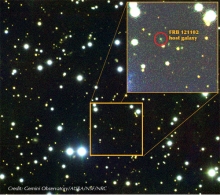If parts of the neutron star interior start to move outwards, the star spins faster. This is called a “glitch,” and it’s providing astronomers with a brief insight into what lies within these mysterious objects.

Category:
Published on: 12 Aug 2019

The afterglow from the distant neutron-star merger detected last August has continued to brighten – much to the surprise of astrophysicists studying the aftermath of the massive collision that took place about 138 million light years away and sent gravitational waves rippling through the universe.
Category:
Published on: 18 Jan 2018

Astronomers have pinpointed for the first time the home galaxy of a Fast Radio Burst, moving scientists a step closer to detecting what causes these powerful but fleeting pulses of radio waves. FRBs, which last just a few thousandths of a second, have puzzled astrophysicists since their discovery a decade ago.
Category:
Published on: 4 Jan 2017
